
The Philippines is an archipelago that comprises 7,641 islands with a total land area of 300,000 square kilometers (115,831 sq mi). It is the world's fifth largest island country. The eleven largest islands contain 95% of the total land area. The largest of these islands is Luzon at about 105,000 square kilometers (40,541 sq mi). The next largest island is Mindanao at about 95,000 square kilometers (36,680 sq mi). The archipelago is around 800 kilometers (500 mi) from the Asian mainland and is located between Taiwan and Borneo.
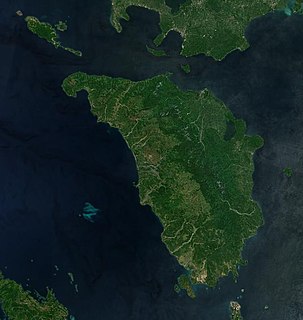
Mindoro is the seventh largest and eighth-most populous island in the Philippines. With a total land area of 10,571 km2 and has a population of 1,408,454 as of 2020 census. It is located off the southwestern coast of Luzon and northeast of Palawan. Mindoro is divided into two provinces: Occidental Mindoro and Oriental Mindoro. San Jose is the largest settlement on the island with a total population of 143,430 inhabitants as of 2015. The southern coast of Mindoro forms the northeastern extremum of the Sulu Sea. Mount Halcon is the highest point on the island, standing at 8,484 feet (2,586 m) above sea level located in Oriental Mindoro. Mount Baco is the island's second highest mountain with an elevation of 8,163 feet (2,488 m), located in the province of Occidental Mindoro.

Panay is the sixth-largest and fourth-most populous island in the Philippines, with a total land area of 12,011 km2 (4,637 sq mi) and has a total population of 4,542,926 as of 2020 census. Panay comprises 4.4 percent of the entire population of the country. The City of Iloilo is its largest settlement with a total population of 457,626 inhabitants as of 2020 census.
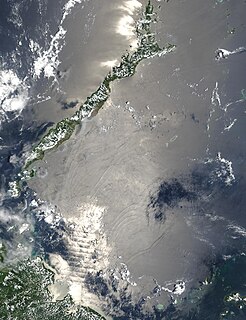
The Sulu Sea is a body of water in the southwestern area of the Philippines, separated from the South China Sea in the northwest by Palawan and from the Celebes Sea in the southeast by the Sulu Archipelago. Borneo is found to the southwest and Visayas to the northeast.

Zamboanga del Norte (Chavacano: Zamboanga del Norte; Cebuano: Amihanang Zamboanga; Subanon: Utara Sembwangan; Tagalog: Hilagang Zamboanga), officially the Province of Zamboanga del Norte, is a province in the Philippines situated within the Zamboanga Peninsula region in Mindanao. Its capital is Dipolog and the province borders Zamboanga del Sur and Zamboanga Sibugay to the south, Misamis Occidental to the east, and the Sulu Sea to the west.

Oriental Mindoro, is a province in the Philippines located on the island of Mindoro under Mimaropa region in Luzon, about 140 kilometres (87 mi) southwest of Manila. The province is bordered by the Verde Island Passage and the rest of Batangas to the north, by Marinduque, Maestre de Campo Island, Tablas Strait and the rest of Romblon to the east, by Semirara and the rest of Caluya Islands, Antique to the south, and by Occidental Mindoro to the west. Calapan, the only city in the island, is the provincial capital.

Antique, officially the Province of Antique, is a province in the Philippines located in the Western Visayas region. Its capital is San Jose de Buenavista, the most populous town in Antique. The province is situated in the western section of Panay Island and borders Aklan, Capiz and Iloilo to the east, while facing the Sulu Sea to the west.

Western Visayas is an administrative region in the Philippines, numerically designated as Region VI. It consists of six provinces and two highly urbanized cities. The regional center is Iloilo City. The region is dominated by the native speakers of four Visayan languages: Hiligaynon, Kinaray-a, Aklanon and Capiznon. The land area of the region is 20,794.18 km2 (8,028.68 sq mi), and with a population of 7,954,723 inhabitants, it is the second most populous region in the Visayas after Central Visayas.
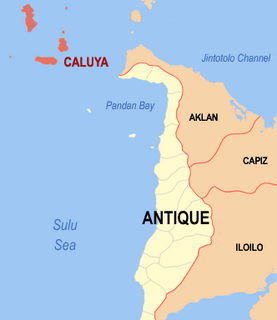
Caluya, officially the Municipality of Caluya, is a 1st class municipality in the province of Antique, Philippines. According to the 2020 census, it has a population of 38,908 people. Making it 6th most populous municipality in the province of Antique.
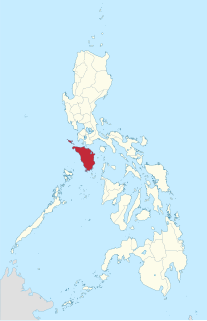
Mindoro was a province of the Philippines from 1902 until 1950 when it was split into two provinces, Occidental Mindoro and Oriental Mindoro. It is located on Mindoro island, Philippines.
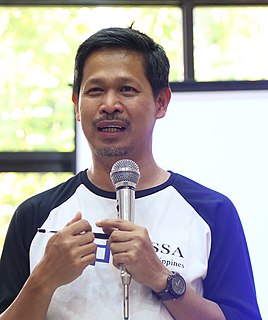
Edwin Gariguez is a Filipino religious leader and environmentalist. He was awarded the Goldman Environmental Prize in 2012, for his voicing of protests on behalf of indigenous communities against large scale mining projects in the Philippines. Edwin Gariguez was the former executive secretary of National Secretariat for Social Action (NASSA), the humanitarian, advocacy and social development arm of the Catholic Bishops' Conference of the Philippines (CBCP).
DMCI Holdings, Inc. is the real estate arm of DMCI Holdings through its wholly owned subsidiary DMCI Project Developers, Inc. (PDI). It was incorporated and registered with the Securities and Exchange Commission (SEC) on April 27, 1995. It ranked #146 in the Business World Top 1000 Corporations for 2014.
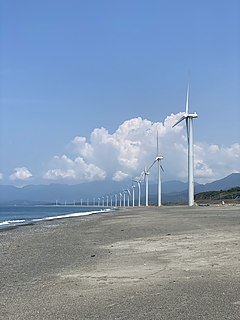
Wind power in the Philippines makes up a small percentage of the total energy output of the Philippines. The country wind energy sector has significant potential and could provide up to 76GW of power. Some of the most recent wind energy developments are the Bangui Wind Farm, Burgos Wind Farm, and Caparispisan Wind Farm in Ilocos Norte, the Wind Energy Power System in Oriental Mindoro, San Lorenzo Wind Farm in Guimaras, Nabas Wind Farm in Aklan and Pililla Wind Farm in Rizal. The northern and central parts of Luzon, Mindoro Island, Panay Island, Palawan Island, Leyte Island, and Negros Island are suitable places to generate wind power. Since imported coal and oil make up 44% of the energy used in the Philippines, the Philippine government has worked to increase the domestic energy supply in recent years. In 2008, the government enacted RA9513, which includes policies to integrate and promote solar and wind power as renewable energy sources.
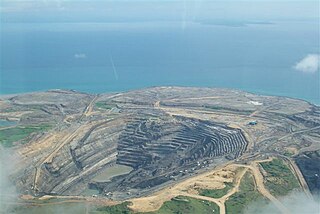
Coal mining in the Philippines has a long history dating back to the 1800s during the Spanish colonization of the islands. The Philippines consumes more coal than it can produce and coal is the main source of electricity. 20% of the country's coal supply is used by the cement industry.

Regina Paz "Gina" La'o Lopez was a Filipino environmentalist and philanthropist who served as Secretary of the Philippines' Department of Environment and Natural Resources (DENR) in an ad interim basis under President Rodrigo Duterte. She was previously the Chairperson of the Pasig River Rehabilitation Commission under two consecutive administrations. Lopez was also a yoga missionary and a pioneer for corporate social responsibility.
Liwagao Island, also known as Libago Island or Libagao Island, is an island located southeast off the coast of Mindoro and northwest off Panay. The island is a disputed feature between the towns of Bulalacao, Oriental Mindoro and Caluya, Antique with the latter exercising de facto administration over the island.
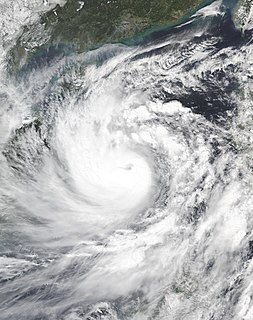
Typhoon Molave, known in the Philippines as Typhoon Quinta, was a strong tropical cyclone that caused widespread damage in the Philippines and Indochina in late October 2020, and became the strongest to strike the South Central Coast of Vietnam since Damrey in 2017. The eighteenth named storm and eighth typhoon of the annual typhoon season, Molave originated from a tropical depression that formed on October 23 east of Palau. At 15:00 UTC the next day, the depression was upgraded into Tropical Storm Molave as it drifted generally northwestward. Molave soon became a typhoon on October 25 as it turned west, shortly before making five landfalls in central Philippines. After striking the Philippines, Molave entered the South China Sea and began to re-intensify. Molave attained its peak intensity on October 27 before weakening again as it approached Vietnam. The typhoon struck Vietnam on October 28, before rapidly weakening as it headed further into Indochina. Molave later dissipated on October 30, over Myanmar.

The Semirara Mining and Power Corporation (SMPC) is a mining company based in the Philippines. The company, a subsidiary of DMCI Holdings, operates its main coal mine in Semirara Island and is the biggest coal producer in the Philippines accounting for 92 percent of the total national production as of 2015.
















